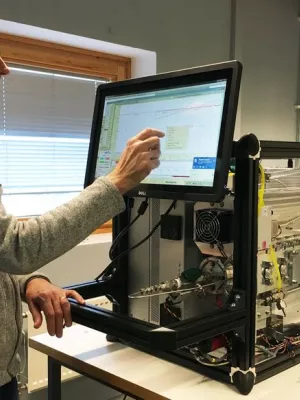
Erik Swietlicki
Professor

Multi-year statistical and modeling analysis of submicrometer aerosol number size distributions at a rain forest site in Amazonia
Author
Summary, in English
The Amazon Basin is a unique region to study atmospheric aerosols, given their relevance for the regional hydrological cycle and the large uncertainty of their sources. Multi-year datasets are crucial when contrasting periods of natural conditions and periods influenced by anthropogenic emissions. In the wet season, biogenic sources and processes prevail, and the Amazonian atmospheric composition resembles preindustrial conditions. In the dry season, the basin is influenced by widespread biomass burning emissions. This work reports multi-year observations of high time resolution submicrometer (10-600nm) particle number size distributions at a rain forest site in Amazonia (TT34 tower, 60km NW from Manaus city), between 2008 and 2010 and 2012 and 2014. The median particle number concentration was 403cm-3 in the wet season and 1254cm-3 in the dry season. The Aitken mode (∼ 30-100nm in diameter) was prominent during the wet season, while the accumulation mode (∼ 100-600nm in diameter) dominated the particle size spectra during the dry season. Cluster analysis identified groups of aerosol number size distributions influenced by convective downdrafts, nucleation events and fresh biomass burning emissions. New particle formation and subsequent growth was rarely observed during the 749 days of observations, similar to previous observations in the Amazon Basin. A stationary 1-D column model (ADCHEM - Aerosol Dynamics, gas and particle phase CHEMistry and radiative transfer model) was used to assess the importance of the processes behind the observed diurnal particle size distribution trends. Three major particle source types are required in the model to reproduce the observations: (i) a surface source of particles in the evening, possibly related to primary biological emissions; (ii) entrainment of accumulation mode aerosols in the morning; and (iii) convective downdrafts transporting Aitken mode particles into the boundary layer mostly during the afternoon. The latter process has the largest influence on the modeled particle number size distributions. However, convective downdrafts are often associated with rain and, thus, act as both a source of Aitken mode particles and a sink of accumulation mode particles, causing a net reduction in the median total particle number concentrations in the surface layer. Our study shows that the combination of the three mentioned particle sources is essential to sustain particle number concentrations in Amazonia.
Department/s
- Nuclear physics
- MERGE: ModElling the Regional and Global Earth system
Publishing year
2018-07-19
Language
English
Pages
10255-10274
Publication/Series
Atmospheric Chemistry and Physics
Volume
18
Issue
14
Document type
Journal article
Publisher
Copernicus GmbH
Topic
- Earth and Related Environmental Sciences
Status
Published
ISBN/ISSN/Other
- ISSN: 1680-7316